Glimpses into a dangerous life
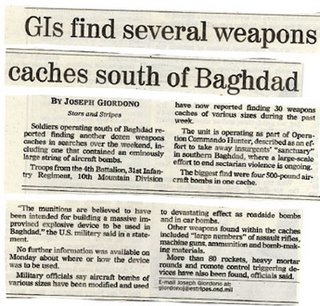
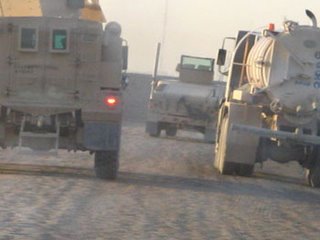
[Heading out with EOD]
DATELINE: Baghdad. Captured enemy cache to be destroyed.
As we approach the checkpoint, my teenaged driver asks if I have ever been out on an EOD call before. He makes it sound as if he’s the washer machine repair guy and the only concern he has is whether he has the right belts and pullies in his truck. “Well, don’t worry none, sir, ‘cause we do this all the time. IEDs, car bombs, unexploded ordinance, we even go out after the fact to collect evidence. Sorta like CSI” he says, apparently rather proud of the comparison. “And if something does explode, we always make sure that we’re far enough away… um… unless something goes wrong.” I didn’t bring up the incident several weeks ago where something went wrong and an EOD team member from Victory was killed trying to defuse a 152mm artillery shell. We all heard that explosion.
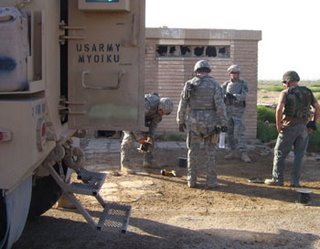
[I like the EOD guys but I wouldn't want their job]
“Like CSI, huh? So what do you do after an explosion?” “Oh, we look for parts to tell what kind of bomb it was, what type of explosive was used… there’s always parts left over. Watch your head, sir, there’s a ‘big bump in the road” [humvee lurches]. “Lots of times if you can tell how a device was detonated, we can figure out a way to defeat it. They used to use a lot of pressure devices, until they got all sophisticated with the radio-controlled stuff. But we jam that, the frequencies I mean. It keeps changing.”
A bored guard waves us through the checkpoint and we pass one of those larger than life roadside paintings of Saddam Hussian that still dot the region. Inevitably, it is faceless; the area where the face should have been is pocketed by small arms fire. “If we have time, I mean - if no one is shooting at us - we can spend most of the morning at a site and tell all sorts of things. But if the area’s still hot, well, we move a little quicker, you know? It’s better out in the country, ‘cause you can never really secure a site in the city, with all the windows and alley ways and stuff. You always have to watch for snipers in the city.”
Finally, the truck ahead of us finally pulls off to the side of the dirt road and our humvee draws up along side. The Buffalo is an armored transport designed specifically for EOD. At first glance, it looks like just another armored truck – you see all sorts out here what with all of the coalition partners bringing their own equipment. But if you look closely you may notice the odd-looking sloped side armor that comes to a “V” at the bottom of the vehicle – the better to deflect the blast from a buried mine.
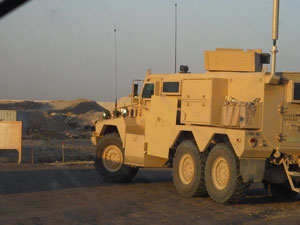
[The Buffalo]
“Ready sir? Here, you can carry this” says the teenager and he hands me a satchel with twelve blocks of C4 in it. I have never held plastic explosive before and I decide that it is aptly named; the small bricks do feel like plastic, and they are malleable, if not entirely flexible. “It’s safe, sir, you can even drop it and it won’t explode without a fuse” (I decide against testing this theory).
Several depressions in the ground are selected and the captured ordinance is placed into it. AK-47s, old Lee-Enfields, a hunting rifle, Soviet-era signal flares, a couple artillery rounds (122s?), and lots of mortar shells. I am surprised at how rusty the mortar shells are, but the teenager assures me they will still fire. There are even a couple of Chinese-made grenades, which generates quite a bit of discussion. The consensus seems to be that no one likes working with Chinese grenades because they tend to go off unexpectedly. Poor manufacturing quality. I file this bit of information away in case of am ever in the market for a case of grenades.
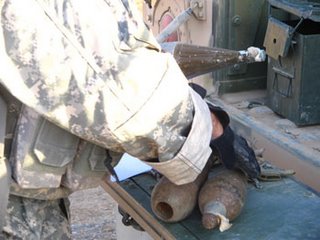
[RPG and Mortar Round]
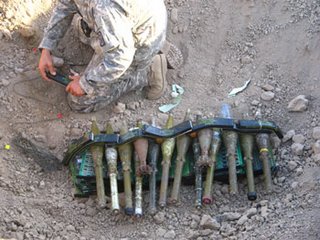
[C4 in the pit]
Finally, all of the weapons are piled up. I hand the blocks of C4 one at a time down to the technician in the pit, who is molding them to the shape of the artillery shells. “Are you sure there won’t be anything left once you blow it up?” “I guarantee it, sir.” He slowly attaches a slender fuse to the final brick, before placing it on top of all the rest, evidently satisfied with his work.
We gather for the safety brief about 300 meters away. “Okay, when I gave the signal, J____ will shout ‘Fire in the hole!’ three times. After the third time, he’ll set off the first charge, five seconds later you go, sir, and five seconds after that, S______ goes. Bang, bang, bang – got it?. Have you ever done this, sir? Ya get a good grip and put yer finger in here and just yank! But ya gotta remember to stay down, ‘cause a couple of those big boys kin throw shrapnel even out here. So stay down for a bit, and if you hear any whizzing go by, after it’s done you can get up. Everybody set?”
The ignition device is deceptively small for the amount of destructive power it holds. It looks like a plastic tube, about 8 inches long, olive drab, with a wire coming out of one end and a pin like a grenade pin on the other. We lay down and wait for the command… “Fire in the hole!” WHUMPP! The first explosion is much LOUDER than I’d expected - I am lifted and body-slammed back onto the ground… my eyes blur. One thousand and one, two thousand… three… four… how many seconds was it? Pull! WHUMPPP!!! The earth convulses. Slam! I wish I’d tightened my chin strap more. I can see the smoke and dust spreading out now… KA-WHUUMPP!!! Slam! Dirt in my mouth.
Silence… You don’t realize how immune you have become to everyday sounds until they are gone. My ears ring in and out. Finally, after seconds that last decades, I hear a bird begin to chirp… life after the storm. We stand up and walk over to the smoking craters. The technician in the pit was right – there was nothing left.
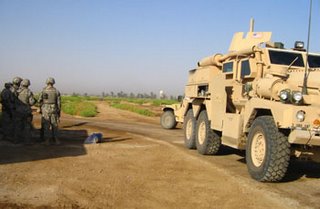

[Me and my Buffalo]

3 Comments:
Wow...wow.
I thought you were saying how mundane and unexciting your work was over there? Sounds pretty dangerous to me.
It's not so dangerous when WE blow it up...
Post a Comment
<< Home